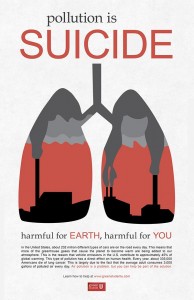From Nate Seltenrich, Environmental Health Perspectives, July 27, 2018
Could air pollution be a trigger for suicide? Researchers first began asking this question less than a decade ago. Accumulated evidence from around the world now suggests there may well be a connection, although the nature of such a connection is still unknown. The authors of a study in Environmental Health Perspectives add to the evidence for this link, drawing upon a robust data set of pollution and suicide figures.
The researchers examined the relationship between daily suicide deaths and daily mean levels of nitrogen dioxide (NO2), sulfur dioxide (SO2), and categories of particulate matter (PM10, PM10–2.5, PM2.5) in 10 large Northeast Asian cities. The data covered one to three decades, depending on the country. The team controlled for variables such as hours of daylight, day of week, and ambient temperature, which can potentially affect the risk of suicide.
On a city-by-city basis, higher levels of air pollution were not always associated with higher suicide risk; in some cities, the association was even reversed, with increases in air pollution associated with lower risks of suicide. But when up to 30 years of information for PM10, NO2, and SO2 was combined across all 10 cities, higher average exposures on the same day and over the previous 1–3 days were associated with a higher daily suicide risk. Combined estimates for PM10 and PM10–2.5 across three cities with two to eight years of data also suggested an increased risk of suicide with higher exposures. However, these estimates were less precise, particularly for PM2.5.
The estimated increases in suicide risk were small but consistent. For example, each 4.3-ppb increase in average daily exposure to SO2 was associated with a 2.0% increase in estimated suicide risk on the same day, while each increase of 36.4 mg/m3 in PM10 was associated with a 1.6% increase in estimated risk.
“Previous studies have considered [data for] maybe a decade or so, but having up to thirty years is a unique contribution,” says University of Utah professor of psychiatry Amanda Bakian, who was not affiliated with the study. “There’s growing evidence to suggest an association between ambient air pollution and suicide risk in diverse populations from around the world.”
Japan, South Korea, and Taiwan share more than just the waters of the East China Sea. They all have above-average suicide rates, with South Korea ranking fourth worldwide in 2016 with 26.9 deaths per 100,000 people and Japan fourteenth with 18.5. Taiwan’s rate of 16 per 100,000 in 2016 also significantly exceeded the global average of 10.6. Worldwide, roughly 800,000 people die from suicide every year.
One major unanswered question is exactly how specific pollutants, or air pollution in general, might influence suicide risk. The young line of inquiry has yet to provide any answers, although some studies have suggested that neuroinflammation may be involved. The authors note that suicide is a complex behavior linked to a number of psychosocial factors. Geographical differences such as cultural backgrounds, socioeconomic factors, and sources and components of air pollution all deserve consideration, they write.
“From my perspective, the broader take-home message relates to how we think about preventing suicide,” says Sunnybrook Research Institute’s Mark Sinyor, a psychiatrist and expert in mood disorders and suicide prevention, who was not affiliated with the study. “Any effort to make an enduring dent in suicide rates must address broader social problems and, as the evidence increasingly suggests, environmental problems such as air pollution as well. That may seem daunting, but at least there is a confluence of agendas—efforts to protect and improve our world are also likely to lead to fewer suicide deaths.”
>>> Nate Seltenrich covers science and the environment from the San Francisco Bay Area.
##########################
See also: “Noise Is The Next Great Public Heatlh Crisis. Here’s How It Will Affect Your Health,” Neel V. Patel, The Future Society, December 19, 2018
https://futurism.com/future-noise-pollution/

